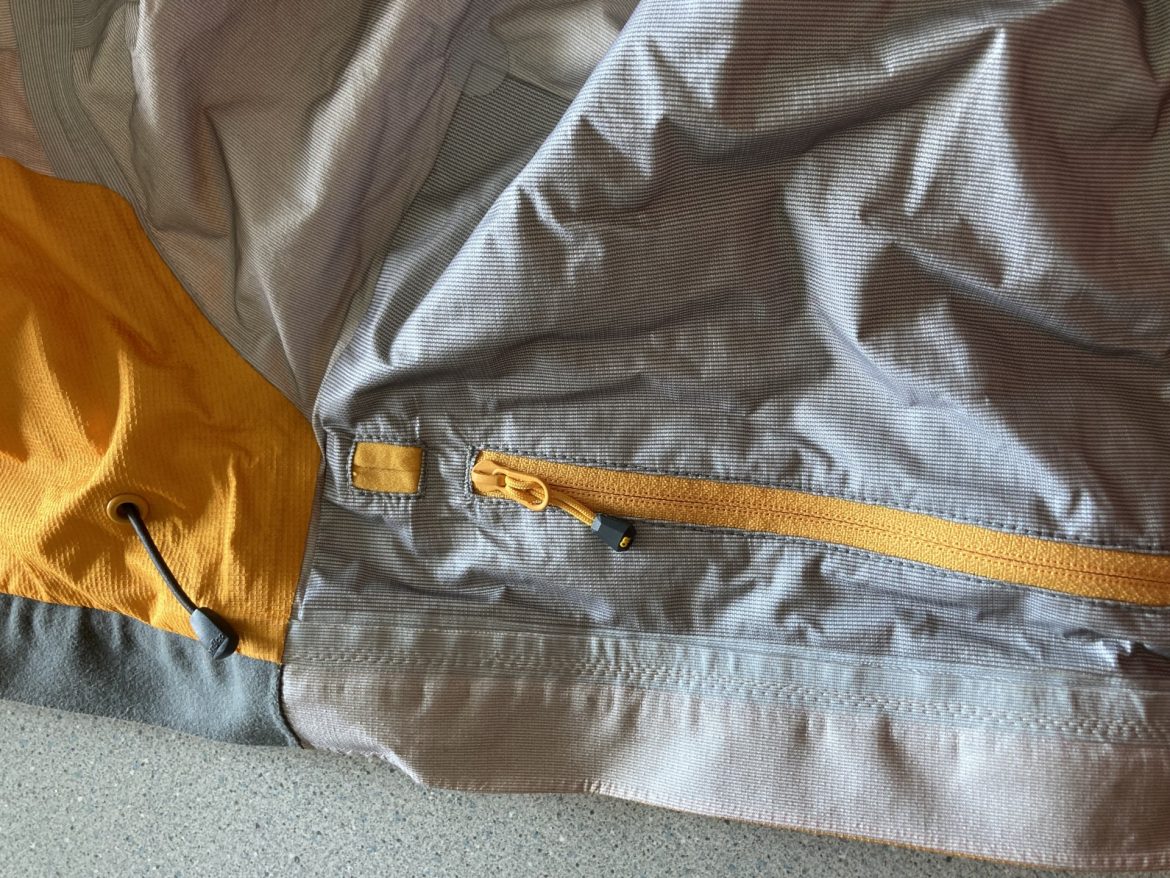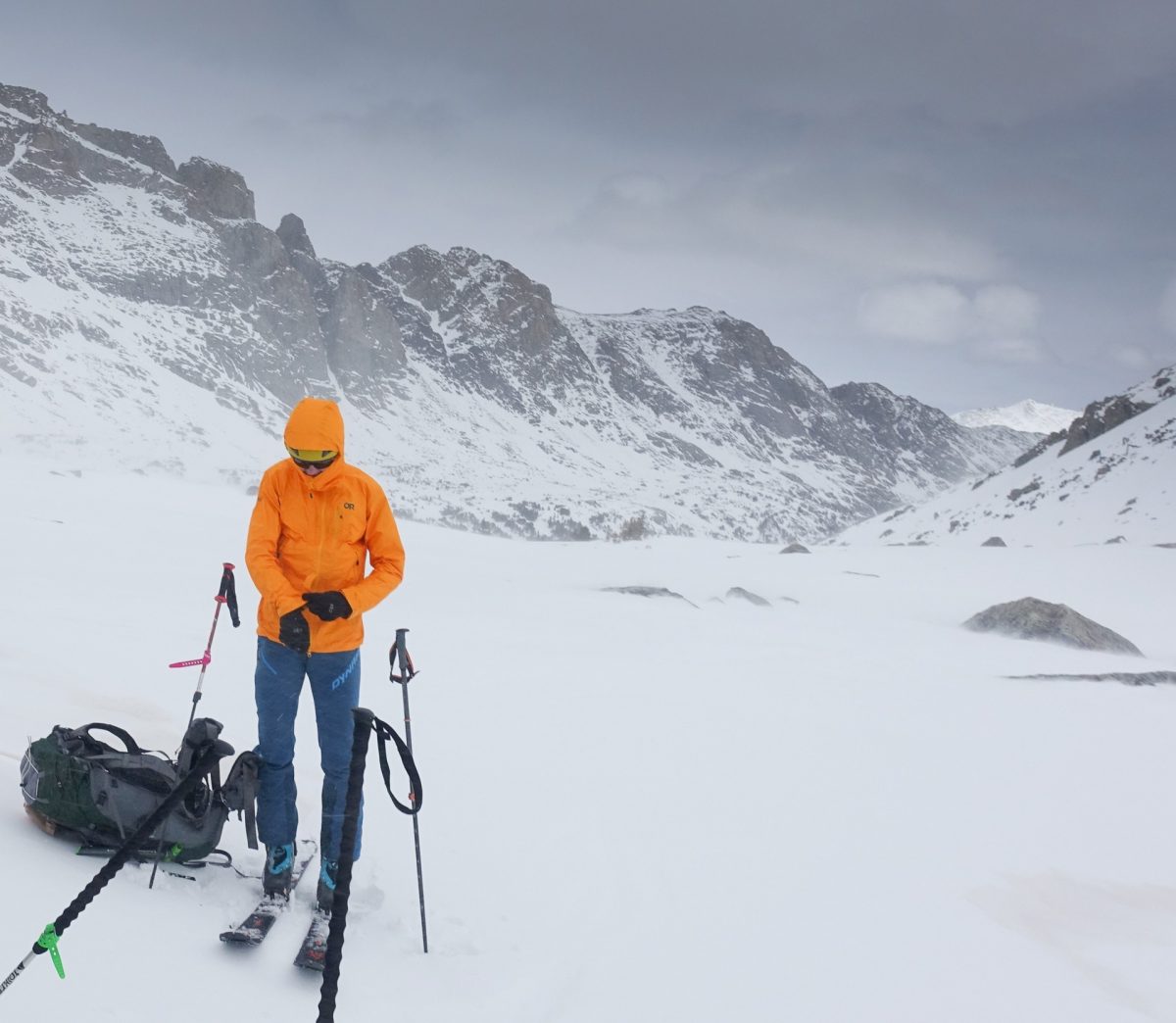
The OR Helium AscentShell in its operational environment. Note the hood is snug over a climbing helmet, good fit otherwise.
The Outdoor Research Helium AscentShell is a weatherproof hardshell with minimal bulk and weight for those who count paperclips and like to stay dry.
Like so many things, when it comes to gear reviews, I believe the world divides into two camps; those that want the quick and dirty low down of a go/no-go and those that need all the nuanced beta they can stuff into their crania. To maximize gross national happiness to the greatest extent, I give you cake and pie! I’ll even accommodate the gluten-free and vegan. Everybody’s happy.
OR Helium AscentShell Jacket – The Quick and Dirty Low Down Go/No-Go
This waterproof breathable Pertex jacket is light at 326 grams (11.5oz), compactable, and roomy, but not ill-fitting for the size and bomber for the weight. The fabric is a touch crinkly, but tactilely pleasing. The first thing I thought when pulling it out of the bag was Tyvek, followed by a thought of, “huh, that’s an interesting feeling fabric, bet I’m gonna get wet in it.” I was wrong; this piece sheds wind and both flavors of precip impressively. Fatty velcro wrist closures provide big targets to grab when your dexterity is compromised in mitts or in that pre-screaming barfies zone of frozen fingers. Or, if your worldview consists of half-empty glasses, you could view these closures as less than svelte.
The Helium AscentShell definitely has a couple of variables to be included in the “needs improvement” category of the report card. My biggest gripe relates to the location and volume of the pockets. This piece has three external pockets of varying volume, two internal drop-in pockets of fine gauge mesh, and a zippered chest pocket similar in size to the external chest pocket.
Let’s chat about pocket location first. If you’re pushin’ this piece as the “pinnacle of alpine protection,” you’re expecting customers to wear this piece with a backpack and/or a harness. So why are you gonna locate pockets right under the waist belt?
There also exists the possibility of strapping some boards to your boots in the alpine, necessitating the need to store skins in said pockets. (At least I like to store skins in my jacket’s front pockets.) It would be most handy to increase the pocket volume to accommodate skins on the down better.
“Dude?” you ask, “throw skins in the interior mesh pockets.”
“Bro-mide,” I reply, “I’d be super stoked to roll that way…if the pocks were grande enough. They’re close, but it’s tight…and it takes both hands to shove the skins in there.
The interior mesh pocket is about a liter and accepts a Nalgene water bottle or a bag of Dot’s pretzels. The left exterior chest pocket is solid; it holds my phone for the gram posts—all good. The right side internal chest pocket is of equal volume, has a headphone wire port, and is great for smallish items like Dermatone and an ID. The hood is just slightly undersized for a helmeted noggin, but I was able to make it work with a BD Half Dome helmet. Otherwise, the first mix of this review: opting for the Helium AscentShell Jacket might save you from a shiver bivy as you can keep trudging on when the elements are spitting moisture this way and that.
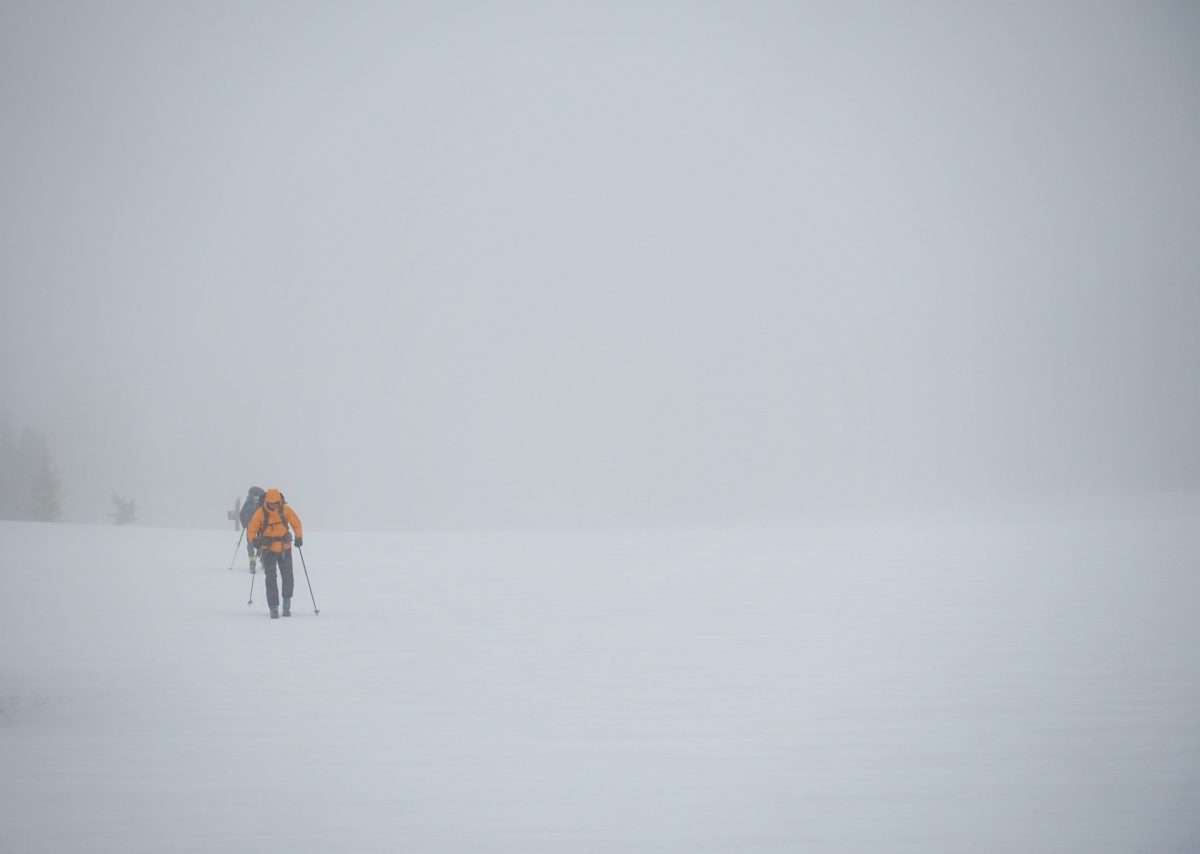
Finding the way in snow-rain while confined in a Wind River ping pong ball. The OR Helium AscentShell provides excellent weather protection.
OR Helium AscentShell Specs
Weight: 326g (medium). The Patagonia Pluma (medium) weighs 414g in a Gore-Tex Pro build.
Seams: Taped and weatherproof.
Hood: Adjustable and mostly helmet compatible.
Fabric: bluesign® approved AscentShell™ x Pertex® Shield Air Diamond Fuse 3L, 100% Nylon 30D Ripstop with 7D Tricot Backer.
Price: $399.00
The Extended Dancehall Remix Version. Oh, you want some more? I got you, dawg.
I received this jacket late in the 21/22 ski season. I packed the AssentShell on spring tours and donned it to ward off late-season storm cycles in the mountains and lower elevation downpours in the valley. On these day tours, I found the Helium AscentShell was quite light, compressed nicely in my pack, had a roomy fit without bagginess, and kept me comfy and secure through big winds and a variety of precip. As my confidence in the jacket increased from my initial trepidation and the gear list items began to be pared down, I packed this piece for a week-long Winds traverse in mid-May. The jacket performed flawlessly through the full range of spring Wyoming weather at elevation, including a powerful late-season storm that chased us out of the mountains but provided a wonderful opportunity to experience wind-driven rain and snow. This jacket kept me dry through it all!
Weight/Compactibility
Refresher: At 326 grams (11.5 oz), the Helium AscentShell is quite light for a full-on condition jacket. (For comparison, the also excellent Patagonia Pluma Gore-Tex Pro jacket (medium) is 414g.) Additionally, the Helium AscentShell balls up small. I stuffed it into a quart Ziploc bag for a silly kitchen trick— the volume is on the order of a Nalgene bottle. Maybe twice the volume of a stuffed Patagonia Houdini jacket (not waterproof).
I would not hesitate to throw the Helium AscentShell into a summit or small pack if there was a decent probability for legit rain or snow. For a slightly greater weight penalty than something like a Houdini (~104g), the Helium AscentShell affords legit weather protection. For the summer, this jacket has found a place in my SAR go pack as it’s small, light, and legit protection should you find yourself out for a night or a week.
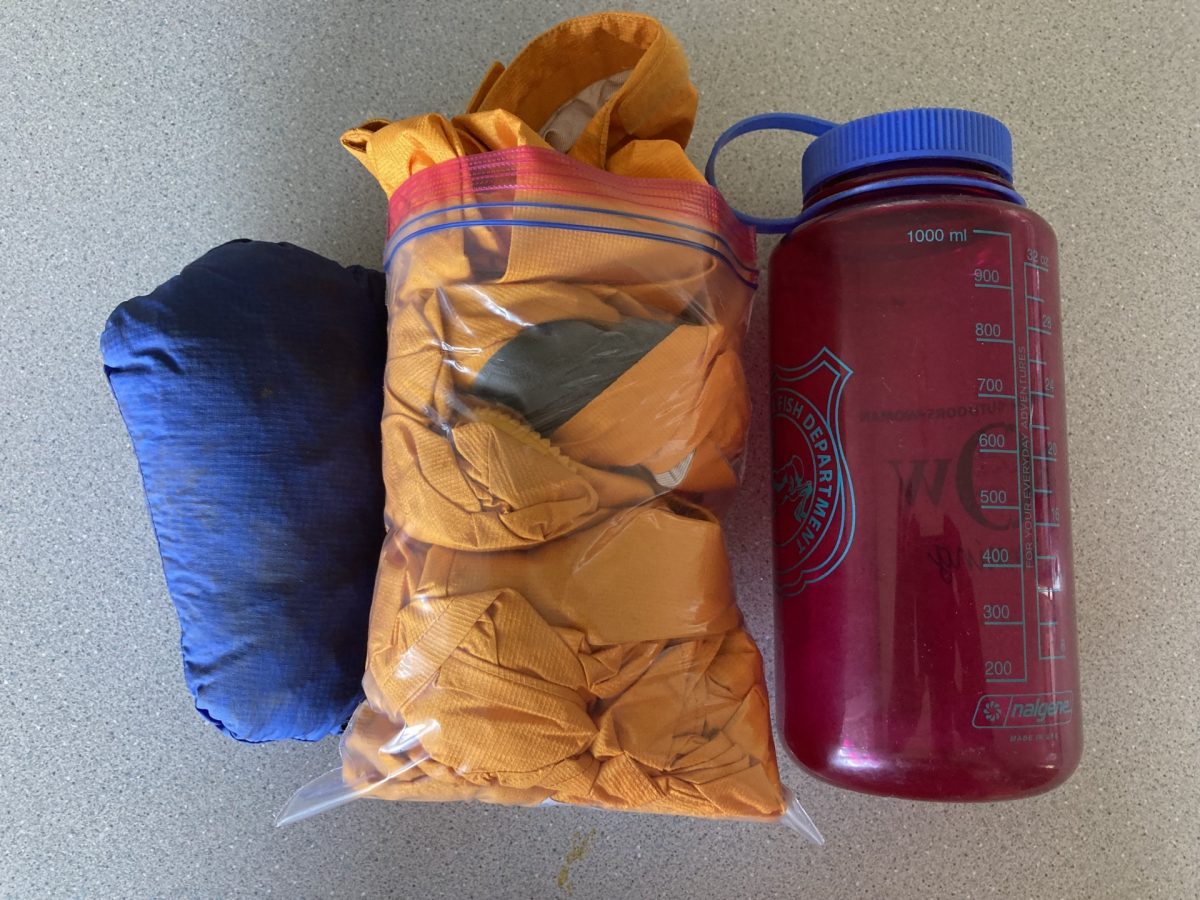
OR Helium AscentShell in a quart ziploc, with a nalgene and stuffed Houdini on right and left, respectively.
Fit
I’m pretty much a medium across the board for North American brand sizing. I’m 6’0″, 156 pounds, in training shape, and consume only a moderate amount of sauce. My chest is 40 inches, and I sport a thirty-four+ inch sleeve. My fit preference is definitely a more svelte and athletic fit than baggy. (No shade, you rock your style, I’ll funk mine.) Based on triple-blind qualitative analysis, I determined the Helium AscentShell to be roomy without being baggy, but I wouldn’t want it any roomier; then we’d be entering jib park realms. I can easily layer various insulative pieces under this shell without feeling restricted. I wore this piece over a combo of a DAS Light Jacket over an Arc’teryx Proton FL. A drawcord hem mitigates the vertical migration of elements.
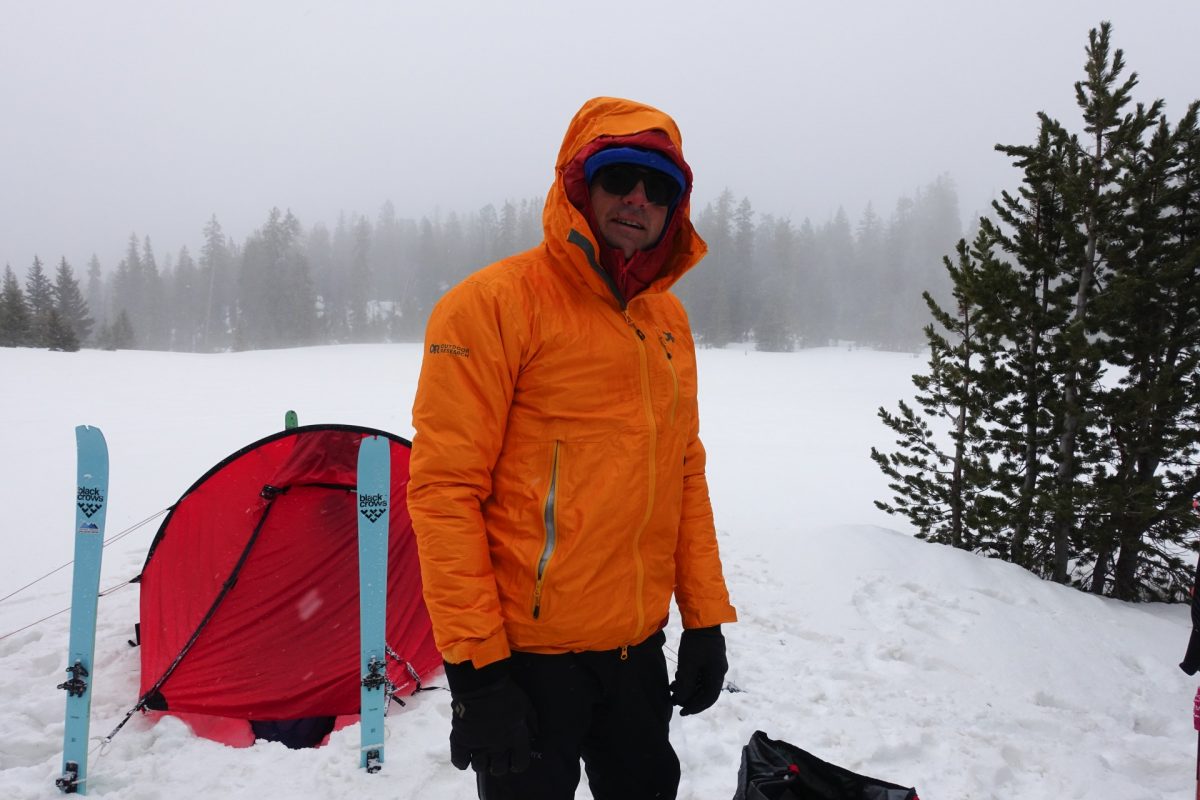
Roomy Fit. Helium AscentShell with a DAS Lite, Arc’Teryx Proton FL and Airshed Pro underneath. Also, note low pocket placement.
Sleeve length is a variable that I’m particularly fixated on. When it’s right, it disappears from my consciousness; when it’s wrong, it’s like water torture and needles my subconscious, resulting in much loathing and reduced gross national happiness. I’m happy to report that the sleeve length is great, and happiness is in black. I have a full range of motion without the sleeve cuff riding up. I attribute this to OR’s “Dynamic Reach Underarm Panels,” which OR markets as providing “excellent mobility for overhead applications.” I agree. Additionally, the sleeve entrance diameter and construction did not produce any armpit bind, all the better for the happiness indices.
Since I’m jabbering about sleeves, let’s talk about cuffs. Cuffs are mediocre plain-Jane, OG velcro tabs — an inch wide with enough tab for you to grab with mitts or gloves. They seem grande in the suite of modern svelte cuff tabs, but they do the job, if a touch bulky.
Like so many hot-button issues these days, hoods, like vests, generate a binary emotional reaction. The pundits will tell us this results from social media influences, a lack of family values, or Satan’s influence. It could be all, but I guess it’s a genetic predisposition; nature/nurture, come real.
Me, for one, I love hoods. Don’t judge my kink. I haven’t always been a lover of hoods. It’s been an evolution, but now I’m a 100% sold-out, dyed-in-the-wool hood bro. Maybe it’s an age thing; who knows? Regardless, the hood on the Helium AscentShell has the usual two lateral adjuster cords at the collar, coupled with the fishhook posterior noggin cords that enhance your peripheral vision — it works great.
The wrasslin match is associated with hood volume. To helmet or not to helmet? The hood volume is great sans ye old noggin protector. Stack multiple hoods from your layers and throw over a toque, no worries. Don a helmet, a BD Half Dome in this case, and things become a little restrictive, ok, quite a bit restrictive.
When I zip the jacket’s “YKK Aquaguard Vislon, double separating front zipper,” while wearing a helmet, I transition into that C3PO, robotic, Blue Man Group-type neck movement. This restriction tweaks my mojo substantially, resulting in the unzipping of said zipper, thereby exposing my grill to the gnar. However, like most things, there is a balance.
Hoods can be too voluminous, accommodating a manner of helmets and resulting in the feel of toting an F350 airbag of fabric behind your nog when unhelmeted. (Looking at you, Arc’teryx.) Bottomline, the hood works, but it’s snug.
Since I just referenced the zipper, I’m going there next. The front zipper has fat gnarly teeth. This is an accolade! No puny zipper teeth to futz with and blow out. These teeth are massive, like Andre the Giant’s in that old Bond movie. The front zipper easily zips up with gloves, and there are no sticky waterproof zips, just straightforward burly zippers. Bravo.
Material
Here’s a mouthful: Just your typical “bluesign approved Helium AscentShell x Pertex Shield Air Diamond Fuse 3L (presumably the L stands for layer?), 100% Nylon 30 D Ripstop with 7D Tricot backer.” According to OR’s marketing video the Helium AscentShell fabric is an “electrospun, air permeable waterproof membrane, laminated to the face fabric of OR’s Helium rain jackets composed of Pertex Diamond Fuse shape yarn technologies.” OR credits all this with enhanced durability and abrasion resistance while providing “extreme weather protection” and comfort “during high output activities.”
In brief, the fabric has been waterproof and windproof.
Here’s my layman’s (lame man’s) translation: the fabric has a small grid structure, both interior, and exterior. This design seemingly raises the fabric off your inner layers and facilitates air flow, resulting in greater comfort across a range of temperatures. The material has a “matte” feel, for lack of a better term; again, Tyvek is what the fabric reminds me of. I skied this jacket on tight-tree days, and the jacket withstood repeated branch encounters without a blemish. I was pleasantly surprised by the fabric’s resilience and durability, given its weight and denier.
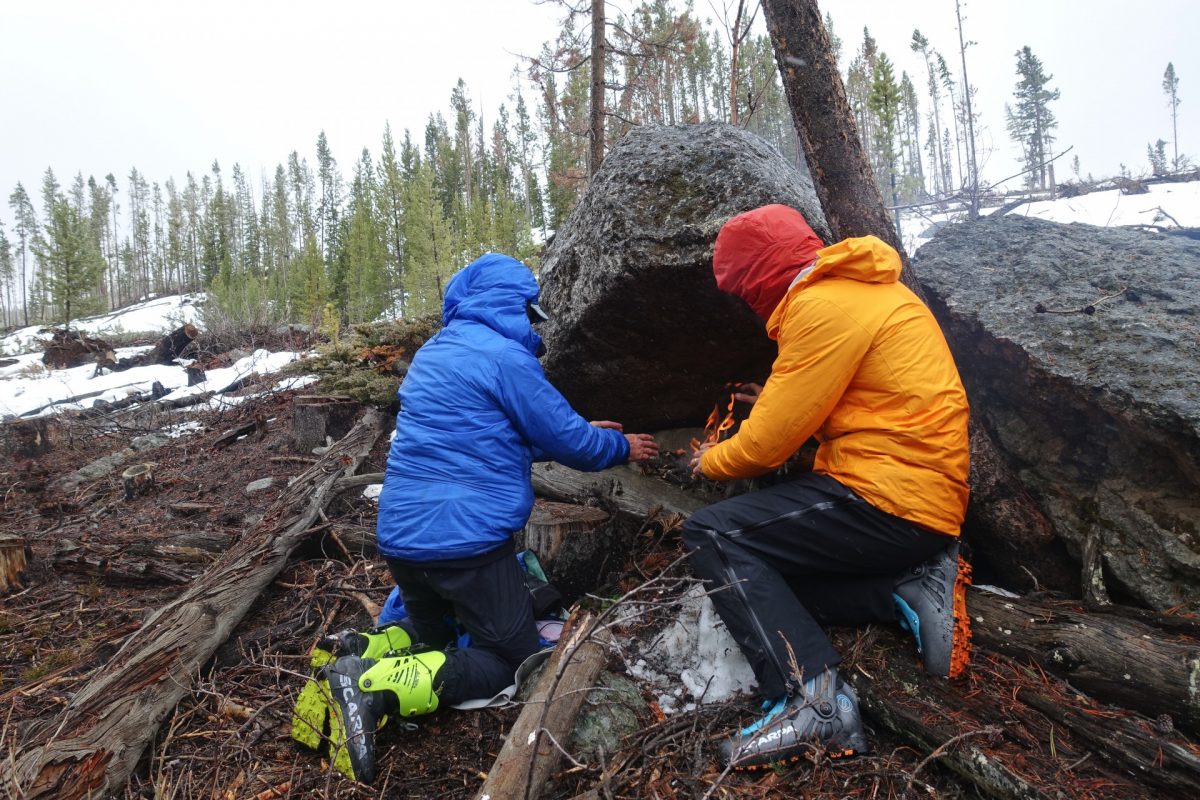
Wyoming? It’s a dry heat…33 degrees with a rain-snow mix, OR Helium AscentShell kept me dry during full-on hypothermic conditions.
Last day of our Winds traverse, a big multi-day spring system rolled in overnight. You know the setup: beautiful high pressure the preceding day gives way to the build overnight, traps radiational heat, starts raining before shooting lightning, then the temps drop, and the rain turns to wet snow, then dryer snow as the thermometer continues to fall. It’s the kind of weather where one quickly learns of any chinks in their armor, emotionally or physically, as in one’s physical gear. The bonus of this situation was the utterly rotten, collapsing snow encountered as we descended toward the exit trailhead.
The previous four days of high pressure and high temps destroyed the integrity of the lower elevation snowpack resulting in the wholesale collapse of ski-length sections of snowpack. Extricating oneself from this situation was a certifiable pig wallow. I bring this postholing-with-skis-on slog story up now to paint the picture of profound perspiration production perpetuated by the putrid snowpack.
Sweating from posthole exhumation while the sky pissed a rain-snow mix, the Helium AscentShell was rocking it: no trash bag clamminess or soaked-through cotton hoody. I was thoroughly impressed with the fabric’s ability to breathe and fight off the precip, keeping me cool, calm, and collected.
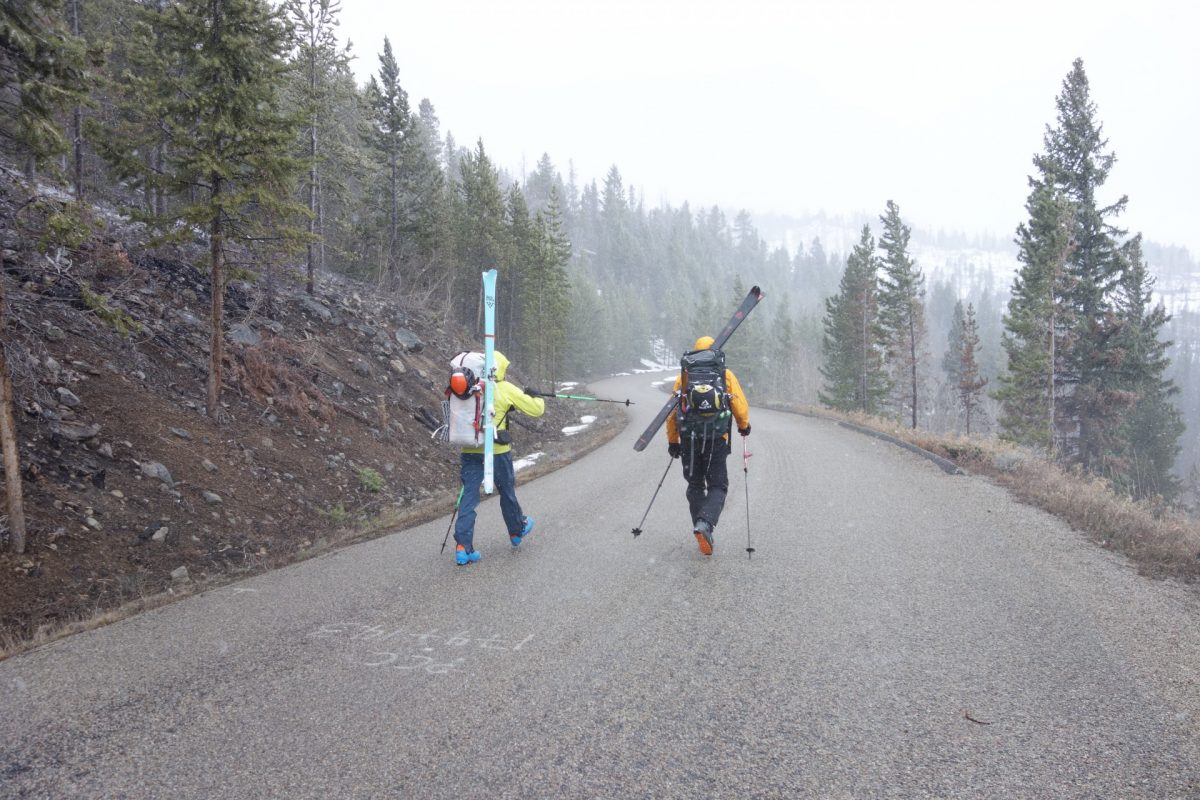
You can smell the post-trip beer from here. The Helium AscentShell keeps me dry on the road slog to the far side of the drift. Photo: Kelly Cordes
Ok, let’s wrap this up. This critter is light, compressible, and fully functional in the shizzle. The fit is comfortable yet trimmed. There are many pocket options, but location and volume need some design love for backcountry skiers. The $399.00 price tag keeps this piece in play if you are looking for a full-value jacket that easily crosses over to alpine adventures once the snow melts.
Shop for the Outdoor Research Helium AscentShell.
Brian wanders through the hills from his home in Lander, Wy.


